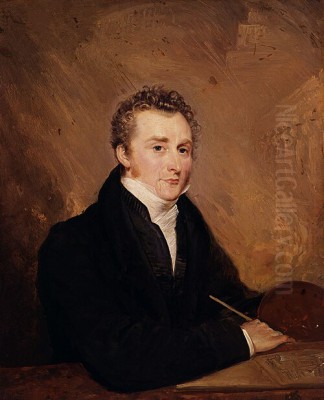
John Martin (1789-1854) stands as one of the most distinctive and popular, yet simultaneously controversial, figures in 19th-century British art. A master of the dramatic, the sublime, and the apocalyptic, Martin captivated the public imagination with his vast canvases depicting biblical catastrophes, mythical landscapes, and fantastical architectural visions. Though often sidelined by the critical establishment of his day, his work resonated deeply with a wide audience and left a lasting legacy that continues to influence visual culture. This article explores the life, work, style, and enduring impact of this unique Romantic artist.
Early Life and Artistic Beginnings
John Martin was born on July 19, 1789, near Haydon Bridge in Northumberland, England. His origins were humble; his father, Fenwick Martin, had a varied career that included stints as a fencing master, innkeeper, tanner, and coachman, suggesting a life marked by financial instability. This background perhaps instilled in the young Martin a drive and ambition that would characterize his later career.
His initial artistic inclinations led him to an apprenticeship in Newcastle upon Tyne, first at a coach-building firm where he learned heraldic painting, and subsequently under an Italian painter named Leonard Wilson, focusing on decorative painting. However, disputes over wages cut this formal training short. Seeking greater opportunities, Martin made the pivotal decision to move to London in 1806, following his former Newcastle master, Boniface Musso, an Italian artist specializing in porcelain and enamel painting.
In London, Martin initially supported himself by painting on glass and china alongside Musso. He married Susan Garrett two years after his arrival. Despite lacking formal academic training from institutions like the Royal Academy Schools, Martin was determined to make his mark as a serious artist. He dedicated his evenings to studying perspective and architecture, honing the skills that would become hallmarks of his dramatic compositions.
Rise to Prominence: Visions of Power and Ruin
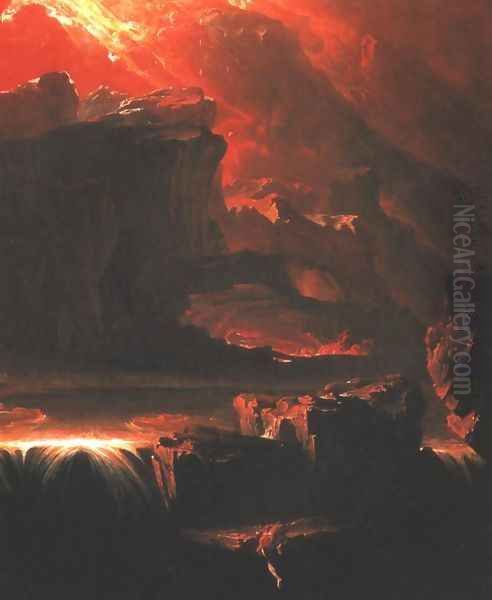
Martin began exhibiting watercolour landscapes, but his ambition lay in creating large-scale, dramatic history paintings. His breakthrough began tentatively with works submitted to the Royal Academy and the British Institution. A key early success was Sadak in Search of the Waters of Oblivion (1812), inspired by the Tales of the Genii, which demonstrated his burgeoning interest in sublime landscapes and literary themes.
His reputation truly soared with Joshua Commanding the Sun to Stand Still upon Gibeon, exhibited in 1816. This large, complex canvas, filled with dramatic action and architectural detail under a tumultuous sky, captured public attention and earned him acclaim, although the Royal Academy hung it poorly. It established Martin's penchant for biblical subjects rendered with operatic intensity.
The work that cemented his fame was Belshazzar's Feast (1820). Exhibited at the British Institution, it was an immediate sensation. Depicting the biblical story of the writing on the wall during the feast of the Babylonian king, the painting overwhelmed viewers with its immense scale, intricate architectural detail, dramatic lighting, and sense of impending doom. It became one of the most talked-about paintings of its time, attracting huge crowds and establishing Martin as a major artistic force, albeit one operating somewhat outside the traditional academic mould.
Artistic Style and Thematic Concerns
John Martin's art is instantly recognizable for its unique blend of the sublime, the dramatic, and the meticulously detailed. His style evolved but consistently revolved around several key characteristics and themes.
The Sublime and the Apocalyptic
Martin is perhaps best known as a painter of the sublime, evoking feelings of awe, terror, and wonder in the face of overwhelming power – whether natural, divine, or man-made. He specialized in depicting cataclysmic events: floods, earthquakes, fires, and divine judgments. Works like The Destruction of Pompeii and Herculaneum (1822) and The Deluge (c. 1834) showcase his ability to render scenes of mass destruction on an epic scale.
His canvases often feature vast, almost infinite perspectives, filled with towering mountains, cavernous spaces, or sprawling cities. Tiny human figures are dwarfed by their surroundings, emphasizing humanity's insignificance before the forces of nature or God. This contrast between the minute and the immense became a signature element of his compositions, heightening the sense of drama and scale.
Biblical Narratives and Moral Spectacle
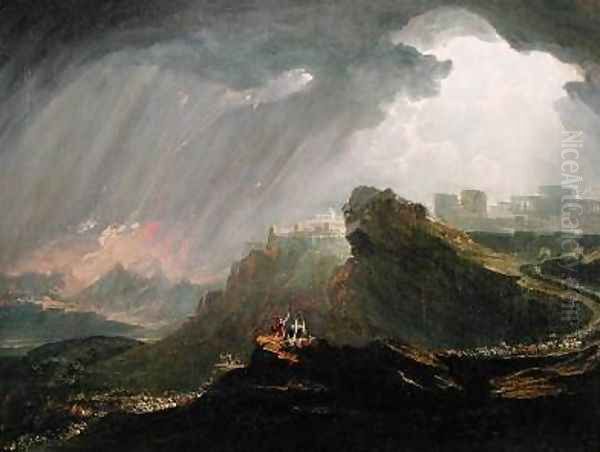
Religious themes, particularly from the Old Testament and the Book of Revelation, were central to Martin's oeuvre. He returned repeatedly to stories of divine wrath and redemption, such as The Seventh Plague of Egypt (1823) and his final, monumental triptych: The Last Judgment, The Great Day of His Wrath, and The Plains of Heaven (completed 1851-1853).
These works were not merely illustrations; they were grand moral spectacles designed to impress and instruct the viewer. Martin used dramatic lighting, swirling compositions, and intricate detail to convey the terror of judgment and the serenity of salvation. The Plains of Heaven, for instance, offers a tranquil counterpoint to the fiery destruction depicted in The Great Day of His Wrath, showcasing his ability to portray both damnation and paradise.
Light, Shadow, and Architectural Fantasy
Martin possessed a remarkable command of light and shadow (chiaroscuro), using it to create dramatic focal points, enhance mood, and define his complex spaces. He often employed stark contrasts, plunging vast areas into deep shadow while illuminating key elements with almost supernatural light, a technique sometimes described as creating "visible darkness."
His fascination with architecture is evident in the elaborate, often fantastical structures that dominate many of his paintings. While sometimes inspired by historical accounts or archaeological findings, his architectural visions often sprang from his own imagination, creating dreamlike or nightmarish cityscapes that added to the otherworldly quality of his work. His meticulous attention to perspective and detail lent these scenes a convincing, if heightened, reality.
Romantic Sensibilities
Martin's work aligns strongly with the broader currents of European Romanticism. His emphasis on emotion, imagination, the power of nature, historical and mythological subjects, and the individual's confrontation with the overwhelming forces of the universe are all characteristic Romantic concerns. He shared thematic ground with contemporaries like J.M.W. Turner, though their painterly styles differed significantly. Martin's dramatic intensity also finds parallels in the work of French Romantic painters such as Eugène Delacroix.
Master of Mezzotint: Spreading the Vision
Beyond his large-scale paintings, John Martin was a highly accomplished and innovative printmaker, particularly in the medium of mezzotint. Mezzotint, a tonal engraving process capable of producing rich blacks and subtle gradations of tone, was perfectly suited to capturing the dramatic light and shadow effects of his paintings.
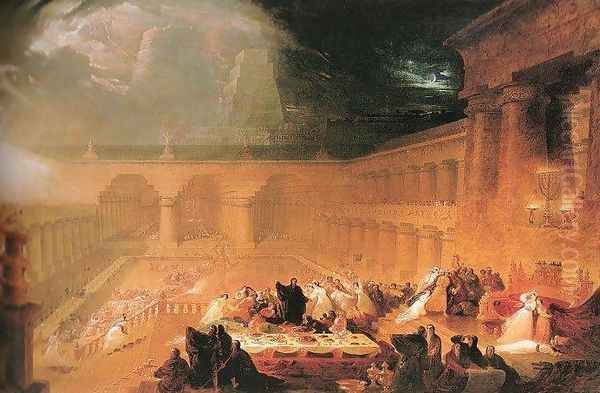
Martin produced numerous mezzotints based on his most famous paintings, including Belshazzar's Feast. These prints were immensely popular and commercially successful, allowing his dramatic visions to reach a far wider audience than his paintings alone could. They were sold in large numbers both in Britain and internationally, particularly in the United States, significantly contributing to his fame and income.
He also undertook major illustration projects, most notably a series of mezzotints for John Milton's epic poem Paradise Lost. These illustrations are considered among his finest works in print, powerfully visualizing the poem's cosmic scope and dramatic intensity. His skill as a printmaker was crucial to his popular success and ensured the wide dissemination of his unique artistic vision.
Critical Reception and Controversy
Despite his immense popularity with the public, John Martin faced significant criticism from the art establishment and influential critics of his day. While crowds flocked to see his spectacular paintings, figures like the influential art critic John Ruskin were dismissive. Ruskin, a champion of naturalism and detailed observation found in the works of artists like Turner, criticized Martin's work for what he perceived as melodrama, theatricality, and a lack of truth to nature.
Other critics echoed these sentiments, sometimes labelling his work as sensationalist spectacle rather than serious art. The Royal Academy, the bastion of artistic orthodoxy in Britain, consistently kept Martin at arm's length. Although he exhibited there, he was never elected a full Academician, a reflection of the establishment's reservations about his dramatic, often unconventional style.
This critical divide highlights a recurring tension in art history between popular appeal and critical validation. Martin's work appealed directly to the public's appetite for drama, spectacle, and religious awe, often bypassing the more refined tastes favoured by the Academy and its associated critics. His success was largely built on independent exhibitions and the sale of his prints, operating outside the traditional patronage systems.
Beyond Painting: Engineering Schemes and Scientific Interests
John Martin was a man of diverse interests, extending beyond the canvas into the realms of science, engineering, and urban planning. Reflecting the era's burgeoning industrial and technological advancements, he developed numerous ambitious schemes aimed at improving London's infrastructure.
He devoted considerable time and energy to designing plans for a clean water supply system for London, improved sewage systems, and even an early concept for a metropolitan railway (a precursor to the London Underground). He also patented inventions related to elastic timber and laminated wood construction.
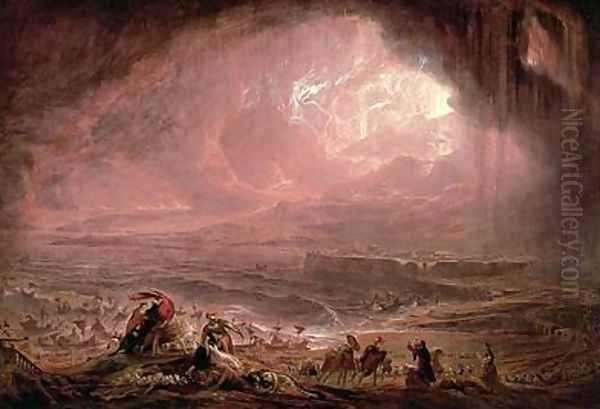
These projects, though often ingenious, were largely unrealized. They faced bureaucratic hurdles, lack of funding, and perhaps skepticism about an artist venturing into complex engineering fields. However, they reveal Martin's inventive mind, his engagement with the practical problems of his time, and a desire to apply his visionary imagination to tangible improvements for society. His social circle included figures interested in science and invention, such as the physicist and inventor Sir Charles Wheatstone, known for his work on telegraphy and the stereoscope, who was a friend and attended Martin's gatherings.
Personal Life and Challenges
Martin's personal life was not without its difficulties. His marriage to Susan Garrett produced six children, but sources suggest it may not have been entirely happy, though details are scarce. A more profound shadow was cast by his family, particularly his older brother, Jonathan Martin.
Jonathan suffered from mental illness and religious fanaticism. In 1829, he achieved notoriety by setting fire to York Minster, causing significant damage to the historic cathedral. Jonathan was subsequently tried, found not guilty by reason of insanity, and confined to an asylum for the rest of his life. This event deeply affected John Martin, likely contributing to periods of depression.
Later in life, Martin faced health challenges. In November 1853, while working on his final triptych, he suffered a severe stroke which left his right side paralyzed and affected his speech. He was moved to the Isle of Man for convalescence but died there a few months later, on February 17, 1854, at the age of 65.
Connections and Contemporaries
During his career, John Martin moved within London's vibrant artistic and intellectual circles, though he remained something of an outsider to the core establishment. He associated with fellow artists, writers, and scientists. His friendship with Charles Wheatstone is well-documented, and Wheatstone reportedly demonstrated his inventions at Martin's home.
He also shared lodgings for a time with Prince Leopold of Saxe-Coburg, who later became the first King of the Belgians (Leopold I) and reportedly wrote a memoir about the artist. Martin's social gatherings attracted various figures, and it's noted that the famous illustrator Sir John Tenniel (later known for Alice's Adventures in Wonderland) was a friend of Martin's children. He also had connections with prominent figures like the writer Charles Dickens and the scientist Michael Faraday.
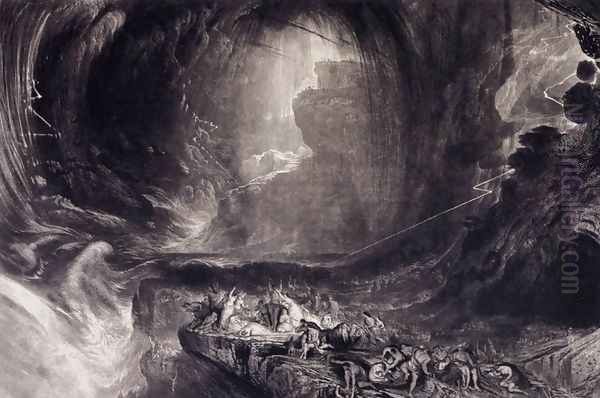
In the art world, his relationship with J.M.W. Turner was complex; they were contemporaries exploring themes of the sublime, but stylistically distinct rivals. Martin's dramatic narrative style found echoes later in the work of the French illustrator Gustave Doré. His influence extended across the Atlantic, notably impacting the dramatic landscapes of the American Hudson River School painter Thomas Cole, who saw Martin's work during a visit to London.
Later Works and Final Years
Despite declining health and the lingering effects of his brother's notoriety, Martin continued to work with determination in his later years. His final major project was the ambitious "Judgment Triptych," comprising The Plains of Heaven, The Last Judgment, and The Great Day of His Wrath. These large canvases summarized his lifelong preoccupation with biblical prophecy, divine power, and the fate of humanity.
He worked on these paintings even after his debilitating stroke in 1853, reportedly giving instructions for their completion. The triptych was exhibited posthumously to great public interest, serving as a final testament to his enduring vision and dramatic power. These works encapsulate the core themes and stylistic elements that defined his career: vast scale, dramatic contrasts of light and dark, intricate detail, and the awe-inspiring depiction of apocalyptic events.
Legacy and Reappraisal
John Martin's reputation underwent significant fluctuations after his death. While immensely popular during his lifetime, his fame waned in the later 19th and early 20th centuries as artistic tastes shifted towards Realism, Impressionism, and Modernism. His work was often dismissed as Victorian melodrama, lacking the painterly finesse or perceived intellectual depth favoured by later generations.
However, the mid-20th century saw a gradual reappraisal of his art. The rise of Surrealism led some artists and critics to recognize Martin as a precursor, admiring the dreamlike, fantastical, and often disturbing qualities of his architectural and landscape visions. His dramatic compositions and imaginative scope found renewed appreciation.
His influence can be traced in various fields. His apocalyptic imagery arguably prefigures the spectacular scenes found in early epic cinema and continues to resonate in fantasy art and illustration. Special effects artists like Ray Harryhausen have acknowledged his impact. Contemporary artists, such as the German photographer Andreas Gursky with his large-scale, detailed images, or the British installation artist Michael Nelson, sometimes echo Martin's sense of scale and overwhelming detail.
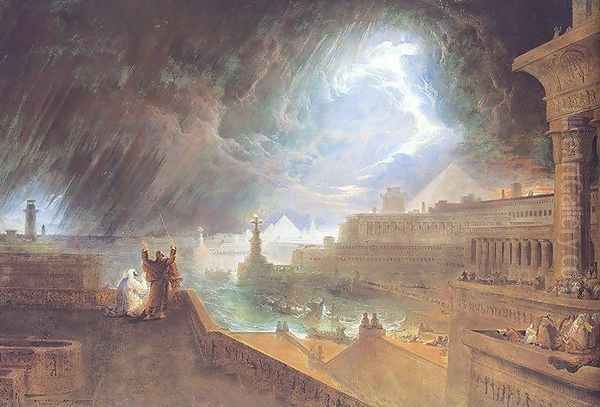
Major retrospective exhibitions, such as the "Apocalypse" show at Tate Britain in 2011-2012 (co-organized with the Laing Art Gallery, Newcastle, and also shown at the Millennium Galleries, Sheffield - Correction: The provided text mentioned New Art Gallery, London, but the major Tate show toured to Laing and Sheffield), brought his work back into the spotlight, allowing new audiences to experience the power and complexity of his vision. His paintings are now held in major museums worldwide, including the Tate, the Louvre, the National Gallery of Art in Washington D.C., and the Metropolitan Museum of Art.
Conclusion
John Martin remains a fascinating and somewhat paradoxical figure in British art history. He was a visionary artist who achieved immense popular success through dramatic, large-scale paintings and widely distributed prints, yet he was often scorned by the critical elite. His work explored the extremes of human experience – divine judgment, natural catastrophe, architectural fantasy – with a unique blend of meticulous detail and theatrical grandeur.
An innovator in mezzotint, an ambitious (if unsuccessful) engineer, and the creator of some of the most memorable apocalyptic images in Western art, Martin carved out a unique path. His legacy lies not only in his spectacular canvases but also in his demonstration of art's power to captivate a mass audience and his enduring influence on how we visualize the epic, the sublime, and the end of the world. His work continues to provoke awe and debate, securing his place as a significant, if unconventional, master of the Romantic era.